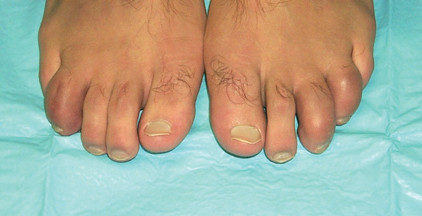MKSAP Quiz: joint pain and plaque psoriasis
A 44-year-old man is evaluated for a 2-year history of joint pain in the wrists, hands, knees, ankles, and feet. He also has a 12-year history of plaque psoriasis. His current medications include acetaminophen for joint pain, topical hydrocortisone and calcipotriene ointments, and a tar-based shampoo> He does not drink alcoholic beverages and has no history of liver disease.
On physical examination, vital signs are normal. There are large erythematous plaques with an overlying silvery scale on the elbows, knees, sacrum, and scalp. The wrists are swollen and warm bilaterally, and there is bilateral synovitis of the metacarpophalangeal joints. There are effusions on both knees. The appearance of the toes is shown.

Screening laboratory tests, including metabolic profile, renal function, and liver chemistry tests, are normal.
After discussing medication options, the patient refuses to begin therapy with tumor necrosis factor a inhibitors because of concern about possible side effects.
Which of the following is the most appropriate treatment for this patient?
A. Hydroxychloroquine
B. Ibuprofen
C. Methotrexate
D. Prednisone
E. Sulfasalazine
Answer and critique
The correct answer is C: Methotrexate. This question can be found in MKSAP 15 in the Rheumatology section, item 39.
This patient has psoriasis, dactylitis, and symmetric peripheral polyarthritis involving the small joints. This constellation of symptoms raises strong suspicion for psoriatic arthritis. Methotrexate is the most appropriate treatment for this patient.
Psoriatic arthritis affects 20% to 40% of patients with psoriasis and is most likely to develop in patients with psoriasis who have extensive skin involvement. Patients with psoriatic arthritis also may have arthritis solely involving the distal interphalangeal joints; asymmetric oligoarthritis; arthritis mutilans; spondyloarthritis that is often associated with peripheral joint disease; spinal involvement that manifests as inflammatory pain and stiffness of the neck and lower back; and tendinitis of the Achilles tendon, flexor tendons of the fingers, and tendons around the ankles.
Despite an absence of evidence obtained from clinical trials, methotrexate has dominated therapy in patients with psoriatic arthritis for many years and is effective in those who have low risk for bone marrow or liver toxicity. In patients with psoriatic arthritis, methotrexate helps to control cutaneous and musculoskeletal manifestations; long-term therapy with this agent also is well tolerated.
Hydroxychloroquine would be helpful in a patient with rheumatoid arthritis, and this patient's pattern of musculoskeletal involvement is somewhat consistent with this condition. However, rheumatoid arthritis usually spares the distal interphalangeal joints and involves the proximal interphalangeal joints. This patient also has dactylitis, which is characterized by inflammation of the whole digit resulting from joint and tendon inflammation that is typical for psoriatic arthritis but not associated with rheumatoid arthritis. Furthermore, hydroxychloroquine has been associated with severe flares of psoriasis and should be avoided in patients with this condition.
Prednisone therapy may help to relieve this patient's joint symptoms. However, tapering of corticosteroids in patients with psoriatic arthritis may be associated with dramatic flares in skin disease; these agents therefore should be used with caution in this population group. NSAIDs such as ibuprofen may help to alleviate this patient's pain and swelling involving the joints but are believed to similarly exacerbate psoriasis. Furthermore, neither prednisone nor ibuprofen would slow the progression of this patient's articular damage.
Sulfasalazine has modest efficacy in the treatment of joint disease in patients with psoriatic arthritis, and a meta-analysis showed that it may help to relieve skin disease, as well. However, this agent is less effective than methotrexate for both skin and joint disease associated with psoriatic arthritis.
Key Points
- In patients with psoriatic arthritis, methotrexate helps to control cutaneous and musculoskeletal manifestations, slows the progression of joint destruction, and is considered first-line therapy for this condition.




